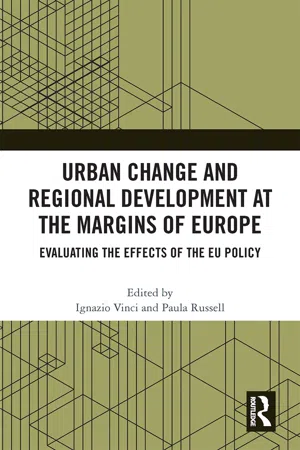
Urban Change and Regional Development at the Margins of Europe
Evaluating the Effects of the EU Policy
- 128 pages
- English
- ePUB (mobile friendly)
- Available on iOS & Android
Urban Change and Regional Development at the Margins of Europe
Evaluating the Effects of the EU Policy
About This Book
Since the beginning of the 1990s, regions and urban areas have become a primary target of EU Cohesion Policy. For a number of European cities, especially in the less developed regions, this has resulted in a unique opportunity for the implementation of extensive development projects, as well as delivering innovations in urban policy and local governance.
Through the detailed observation of planning processes which took place in four European cities – Porto (PT), Malaga (ES), Palermo (IT), and Thessaloniki (EL) – this book explores the different ways that EU intervention can affect the policy process locally, from the regeneration of decayed neighbourhoods and the creation of key services for improving the quality of life, to the establishment of new governance relations and increasing the institutional capacity in local government.
The book also provides a critical reflection on the impact of EU urban policy in reducing regional disparities and the extent to which Cohesion Policy has helped cities to open new pathways for local development. With a special focus on the EU's marginal regions, this book is a guide to understanding how EU policy has affected urban change and local development across Europe.
The chapters in this book were originally published as a special issue of the journal Urban Research & Practice.
Frequently asked questions
Information
Cities and regional disparities in the European Union: evolving geographies and challenges for Cohesion Policy
ABSTRACTSince the nineties, urban areas have assumed a growing importance in EU Cohesion Policy. This process, which is being implemented through various political steps and policy instruments, has led cities to be recognised as key elements in the promotion of balanced development. After decades of planning experiments at different territorial scales, however, the extent to which EU urban policy has contributed to regional development is currently under debate. This paper seeks to describe the evolution of the urban dimension within EU Cohesion Policy, with a focus on the role of cities in those countries and regions experiencing development problems.
1. Introduction
| Country | Population | Number of LDRs(on total) | Extent of LDRs(% Country Area) | Weight of LDRs(% Population) |
|---|---|---|---|---|
| Germany | 63,163,158 | 5 (36) | 30.2 | 23.5 |
| Italy | 57,661,000 | 8 (20) | 40.8 | 36.8 |
| United Kingdom | 57,366,085 | 1 (35) | 5.8 | 2.8 |
| France | 56,735,000 | 5 (26) | 17.9 | 3.0 |
| Spain | 38,868,830 | 10 (18) | 71.0 | 52.4 |
| Greece | 10,160,689 | 13 (13) | 100.0 | 100.0 |
| Portugal | 9,840,897 | 7 (7) | 100.0 | 100.0 |
| Ireland | 3,513,645 | 1 (1) | 100.0 | 100.0 |
| Country | Population | Number of LDRs(of total) | Extent of LDRs(% Country Area) | Weight of LDRs(% Population) |
|---|---|---|---|---|
| France | 66,165,980 | 5 (27) | 14.0 | 3.2 |
| United Kingdom | 64,351,203 | 2 (40) | 6.9 | 3.9 |
| Italy | 60,782,668 | 5 (21) | 27.9 | 28.9 |
| Spain | 46,512,199 | 1 (19) | 8.2 | 2.4 |
| Poland | 38,017,856 | 15 (16) | 88.6 | 86.0 |
| Romania | 19,947,311 | 7 (8) | 99.2 | 88.5 |
| Portugal | 10,427,301 | 5 (7) | 90.4 | 66.2 |
| Greece | 10,926,807 | 6 (13) | 53.0 | 41.0 |
| Czech Republic | 10,512,419 | 7 (8) | 99.4 | 88.1 |
| Hungary | 9,877,365 | 6 (7) | 92.6 | 69.7 |
| Bulgaria | 7,245,677 | 6 (6) | 100.0 | 100.0 |
| Slovakia | 5,415,949 | 3 (4) | 95.8 | 88.5 |
| Croatia | 4,246,809 | 2 (2) | 100.0 | 100.0 |
| Lithuania | 2,943,472 | 1 (1) | 100.0 | 100.0 |
| Slovenia | 2,061,085 | 1 (2) | 61.3 | 53.0 |
| Latvia | 2,001,468 | 1 (1) | 100.0 | 100.0 |
| Estonia | 1,315,819 | 1 (1) | 100.0 | 100.0 |
2. The changing geography of regional disparities under the lens of Cohesion Policy
Table of contents
- Cover
- Half Title
- Title Page
- Copyright Page
- Table of Contents
- Citation Information
- Notes on Contributors
- Introduction
- 1 Cities and regional disparities in the European Union: evolving geographies and challenges for Cohesion Policy
- 2 The influence of EU policy on local policy-making, governance and urban change. Evidence from Porto, Portugal
- 3 Transferring sustainability: imaginaries and processes in EU funded projects in Thessaloniki
- 4 Understanding the influence of EU urban policy in Spanish cities: the case of Málaga
- 5 How the EU regional policy can shape urban change in Southern Europe: learning from different planning processes in Palermo
- Index